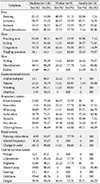1. Ghosh SK. Human cadaveric dissection: a historical account from ancient Greece to the modern era. Anat Cell Biol. 2015; 48:153–169.
2. Brenner E. Human body preservation: old and new techniques. J Anat. 2014; 224:316–344.
3. Coleman R. Reducing the levels of formaldehyde exposure in gross anatomy laboratories. Anat Rec. 1995; 243:531–533.
4. Vohra MS. Personal formaldehyde exposure level in the gross anatomy dissecting room at College of Medicine King Saud University Riyadh. Int J Occup Med Environ Health. 2011; 24:108–113.
5. Raja DS, Sultana B. Potential health hazards for students exposed to formaldehyde in the gross anatomy laboratory. J Environ Health. 2012; 74:36–40.
7. Azari MR, Asadi P, Jafari MJ, Soori H, Hosseini V. Occupational exposure of a medical school staff to formaldehyde in tehran. Tanaffos. 2012; 11:36–41.
8. Yamato H, Nakashima T, Kikuta A, Kunugita N, Arashidani K, Nagafuchi Y, Tanaka I. A novel local ventilation system to reduce the levels of formaldehyde exposure during a gross anatomy dissection course and its evaluation using real-time monitoring. J Occup Health. 2005; 47:450–453.
9. Saowakon N, Ngernsoungnern P, Watcharavitoon P, Ngernsoungnern A, Kosanlavit R. Formaldehyde exposure in gross anatomy laboratory of Suranaree University of Technology: a comparison of area and personal sampling. Environ Sci Pollut Res Int. 2015; 22:19002–19012.
10. Uba G, Pachorek D, Bernstein J, Garabrant DH, Balmes JR, Wright WE, Amar RB. Prospective study of respiratory effects of formaldehyde among healthy and asthmatic medical students. Am J Ind Med. 1989; 15:91–101.
11. Wineski LE, English AW. Phenoxyethanol as a nontoxic preservative in the dissection laboratory. Acta Anat (Basel). 1989; 136:155–158.
12. Gahukar S, Ramteke U, Majumdar D, Malviya R, Patil D, Trivedi J, Rao C, Kale AH. Prevalence of formaldehyde in indoor air of gross anatomy laboratory and cadaver storage room of a medical college. J Environ Occup Sci. 2014; 3:181–185.
13. Shiraishi N. Levels of formaldehyde, phenol and ethanol in dissection room air and measures for reduction. Jpn J Occup Med Traumatol. 2006; 54:1–10.
14. Koirala S, Shah S, Khanal L, Pokhrel C, Poudel D. Effect of formalin among the medical and dental students attending regular laboratory session in dissecting hall, in Department of Human Anatomy, in B.P. Koirala Institute of Health Sciences. Eur J Forensic Sci. 2015; 2:1–4.
15. Elshaer NS, Mahmoud MA. Toxic effects of formalin-treated cadaver on medical students, staff members, and workers in the Alexandria Faculty of Medicine. Alex J Med. 2017; 53:337–343.
16. Gurbuz N, Coskun ZK, Liman FA, Anıl A, Turgut HB. The evaluation of formaldehyde exposure in the anatomy laboratories and the preventive measures. Gazi Med J. 2016; 27:98–103.
17. Dimenstein IB. A pragmatic approach to formalin safety in anatomical pathology. Lab Med. 2009; 40:740–746.
18. Ya'acob SH, Suis AJ, Awang N, Sahani M. Exposure assessment of formaldehyde and its symptoms among anatomy laboratory workers and medical students. Asian J Appl Sci. 2013; 6:50–55.
19. Onyije FM, Avwioro OG. Excruciating effect of formaldehyde exposure to students in gross anatomy dissection laboratory. Int J Occup Environ Med. 2012; 3:92–95.









 PDF
PDF ePub
ePub Citation
Citation Print
Print







 XML Download
XML Download